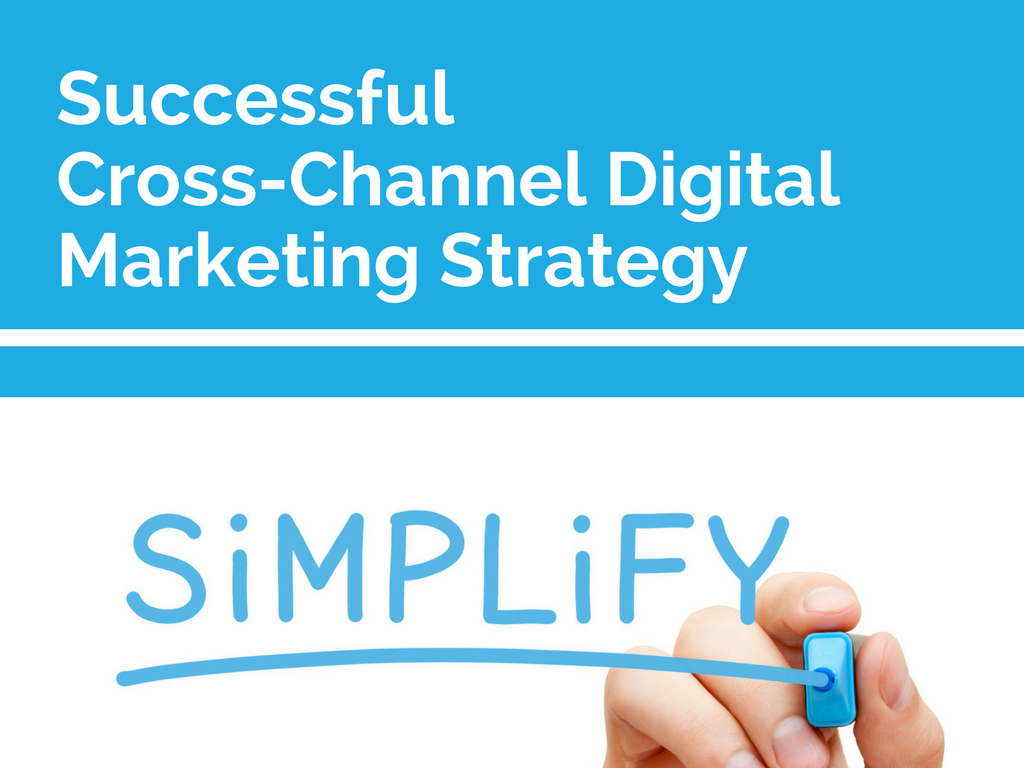- Apr 5, 2017
- By Sarah Tsai
- In Social Media and Digital Marketing
Simplification: the Key to a Successful Cross-Channel Digital Marketing Strategy

If you're not achieving marketing effectiveness, it could be your current digital marketing strategy that is holding you back. With so many digital channels and media types, it's easy to get lost in building followers and getting views while losing sight on the real goal: turning conversions into customers. If your results aren't what you expected, maybe it is time to take a step back to assess whether your current plans are working.
Why Your Current Digital Strategy Isn't Cutting It
Here are some common pitfalls of digital marketing:
- Poor Targeting. It's not enough to get a bunch of people to like your content. You have to get the right people to engage with your content.
- Ineffective Content. Whether your overall engagement is low, or your engagement doesn't seem to be leading to conversions, if your content isn't useful and helpful to your target audience then you're just taking up space.
- Wrong Channels. Not every business is going to be a good fit for every digital channel. Make sure you're picking the right ones for your industry. On the same note, don't spread yourself too thin trying to be everywhere at once. Finding high levels of success from a few channels is much better than treading water on a dozen.
- Missing or Unclear Goals. Digital marketing goals need to be simple and clear — and usually based around building sales. Boosting brand awareness and trust are also good goals, but they are moving targets and difficult to measure. Along with these loose goals, you must have tangible, measurable goals to determine your strategy's effectiveness and progress.
Cross-Channel Marketing Success Is Easier Than you Think
Simple, concise, and clean digital marketing campaigns come from creating compelling messages for your target audience on the right channels. This means taking a holistic view of your customer’s journey, including all the little steps that build up to the big leap of conversion. Before deep diving into any metrics or measurement, here’s what you’ll want to look at:
- Know Your Channels. It is worth restating: you are far better off focusing on a handful of channels with high conversions than to try and hit as many channels as possible. Plus, when you focus on only a few channels your audience uses, it will be much easier to understand how they all fit together and find effective ways to bring people from one channel to another and eventually guide them on their path to purchase.
- Know Your People. Where is your audience and what are they doing? When are they likely to be looking for the solutions you provide? How do they like to find these solutions — videos, blogs, little Facebook nuggets? (Hint: it's likely to be a combination of several formats).
- Create Actionable Solutions with Specific Keywords. Once you know where they are and what they want to see, it's time to boil that down to actionable solutions with keywords and phrases people will use. It is these ideas and keywords that you will build your content and your digital strategy around. You will also use these ideas to set conversion goals that will make your data analyzation more effective.
- Create Unified Content. Don't make the mistake of creating all your blogs at once and all your social media updates separately, and then assigning a different team to do all your video content. Consider each message as something that belongs to all your channels, and then create content that is tailored to the experience of each channel.
- Guide Your Audience through Engagement. At the same time, consider the idea of moving readers from one channel to another. Unless you are doing direct sales, you are not converting customers directly from Facebook or building a client base on LinkedIn. Instead, understand the job of these channels is to move customers to a landing page or website page where they can take action with your business.
Don’t Get Lost in Data
If the ultimate goal is to create a holistic experience for your audience so they can interact with your company, any stand-alone digital strategy — one that focuses on meeting high metrics for the platform without supporting a common end goal — is not going to work. Building an impressive Twitter following or having a blog post go viral are both valuable to a digital marketer, but if they don’t support your end goal of increasing conversions to customers, then you're not getting the full value out of your current strategy. It's not about obsessing over the newest Google update or spending hours creating spreadsheets of data. Staying on top of what Google is doing is good, and data is helpful — but neither will directly bring you more sales.
As marketers, we all know how important data is to our success. But digital marketing metrics don't always paint the most complete picture of a customer's journey. For example, your website performance metrics are vital to your content team and your webmaster, but they won't tell you much about what's going on with a prospective customer who has interacted with a few of your digital initiatives and is hesitating at some point in the journey unless you overlay website data with other data such as conversions or consumer feedback. This leads again to the necessity of a cohesive digital marketing strategy. You know you need to look beyond individual data points to create a Big Picture view of your results, but your strategy itself isn't Big Picture.
Begin with the End in Mind
When you have a cross-channel digital marketing strategy that is built around unified messages and clear end goals, those mountains of data will not only make more sense, but also be more useful. You'll know which heaps of data are interesting rather than helpful and impressive looking but without substance. Being a digital marketer means taking a holistic view of your customer's journey.
For example, take a closer look at that blog post that went viral and see if the message behind it led to more traffic to the landing page you were targeting. If the answer is yes, then rinse and repeat! If the answer is no, you can take a look at the elements of that post that were so effective at driving engagement and exciting readers to share with their friends and organically extending your reach. Then, see if you can replicate that with a message that does a better job of getting those people to go one more step toward a conversion.
Unified and Simplified
One of the biggest benefits of a unified, cross-channel digital marketing strategy is simplification. You'll always be working toward a single goal rather than having to keep tabs on a number of different streams. Along with a simplified experience for you, your readers and customers will also enjoy the cohesive experience you plan and deliver. Interacting with your content will be more meaningful and more helpful. Your brand's awareness will build as people engage with and come to expect your unified experience, and your brand's trust will solidify as your company appears to be better at solving problems because you've mastered the ability to bring a customer from question to solution more effectively.





